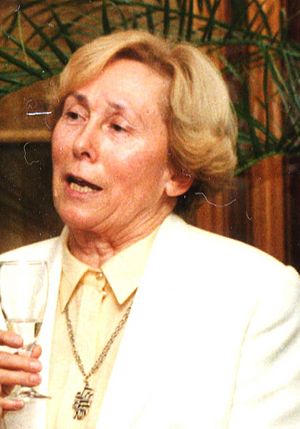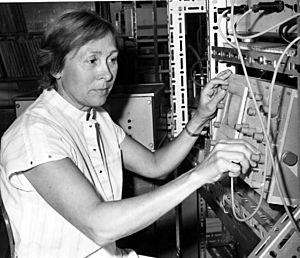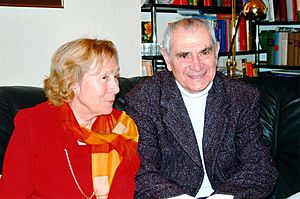Marion Asche facts for kids
Quick facts for kids
Marion Asche
|
|
|---|---|
 |
|
| Born |
Marion Asche
7 January 1935 Berlin, Germany
|
| Died | 11 December 2013 Berlin, Germany
|
| Nationality | German |
| Occupation | Physicist |
Marion Asche (born January 7, 1935 – died December 11, 2013) was a German physicist. She was a professor who studied solid state physics. This field looks at how solid materials behave. She is famous for her important work in semiconductor physics. Semiconductors are materials like silicon. They are used in computers and phones.
Contents
Early Life and Education
Marion Asche was born in Berlin, Germany. This was on January 7, 1935. Her parents were Lisa and Werner Asche. In 1941, she started school in Berlin.
A year later, World War II was happening. There were many bombings in Berlin. So, her mother took Marion and her brother away. They moved to Lauterbach on the island of Rügen. Marion went to school there. In 1945, the family moved back to their home in East Berlin.
Marion finished high school in Berlin in 1953. After that, she studied physics. She went to the Humboldt University of Berlin (HUB). From 1957 to 1959, she worked at the German Academy of Sciences. She studied cadmium sulfide crystals. These are special materials. She earned her physics diploma from Humboldt University.
Starting Semiconductor Research
In late 1959, Marion Asche started working at the German Academy of Sciences. She became a scientific assistant. Her job was to study how different semiconductor materials reacted. She looked at how their electrical resistance changed under pressure. This is called piezoresistance. She studied materials like p-germanium.
To do this, she designed a special setup. She used it to do her experiments. She carried out many long tests. Her first scientific findings were published in 1963.
Toward the end of 1963, a scientist named Oleg Sarbey joined the institute. He was from Kiev, Ukraine. Marion Asche would later marry him in 2005. From then on, she worked very closely with Oleg Sarbey. She also worked with scientists from the Ukrainian Academy of Sciences. In 1964, Marion spent six months in Kiev. Her work there was very successful. In 1965, she earned her doctorate degree. She wrote about "Hot Electrons in Silicon." This means studying how electrons move very fast in silicon.
After this, she continued her research. She studied semiconductors in strong electric fields. Her findings were recognized around the world. In 1970, she earned another advanced degree.
Key Discoveries in Physics
For the next ten years, Marion Asche worked with her Ukrainian colleagues. They studied how things move in strong electric and magnetic fields. This led to many new discoveries.
In 1984, Marion Asche made a big observation. She found something called "spontaneous symmetry breaking." This happened when studying electrons in certain semiconductors at very cold temperatures. Scientists in Kiev had predicted this. This discovery was officially recognized in 1986. It was discovery number 294 by the Soviet Union. It was the first time German scientists were part of such a discovery.
In 1987, she became a professor at Humboldt University.
Marion Asche was a very hands-on scientist. She often prepared her own samples for experiments. She also worked on the theories behind her results. She wrote many research papers. In 1987, she received an award. It was for her "outstanding scientific achievements" in semiconductor physics. The president of the Academy of Sciences of the GDR gave her this award.
She also explored other areas of solid-state physics. She studied how heat moves in materials. She also looked at how light interacts with materials. In her later years, she studied "two-dimensional systems." These are very thin layers of materials.
Working with Scientists Worldwide
Marion Asche was invited to speak at many international conferences. She gave lectures in France, Italy, Austria, and other countries. Even before German reunification in 1989, she spoke in West Germany.
She worked closely with Ukrainian physicists. Before 1989, it was hard for her to talk with scientists from Western countries. After the Berlin Wall fell, she worked a lot with English and West German scientists. This led to many joint scientific papers. She worked with Frederick Koch and Eckehard Schöll.
From 1971 to 1979, she led a group studying hot electrons. From 1990 to 1992, she led a department. This department studied how semiconductors transport electricity. She also helped start the Paul Drude Institute. This institute studies solid-state electronics. She worked there until she retired in 2000.
Wolfgang Richter was a leader of the Physical Society of Berlin. He wrote about Marion Asche in 1999. He said she did great work in bringing Berlin physicists together. This happened after the fall of the Berlin Wall. She was the first woman to lead the board of the society. She held this position from 1994 to 1996.
Published Works
Marion Asche published over 70 articles. These were in international science journals. Two of her articles were review articles. Many other scientists used them as references. She also helped write three books. These books were published in Kiev and Heidelberg. She also wrote articles for a physics encyclopedia.
She was also part of three patents. These are legal rights for new inventions. She also guided many students. She helped them with their diploma and doctoral research.



